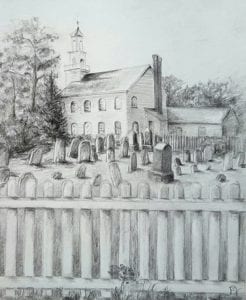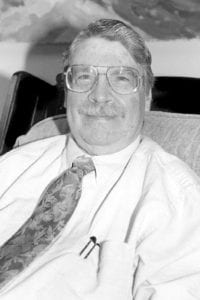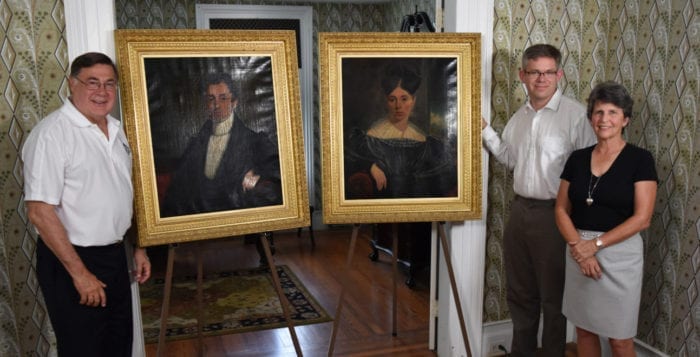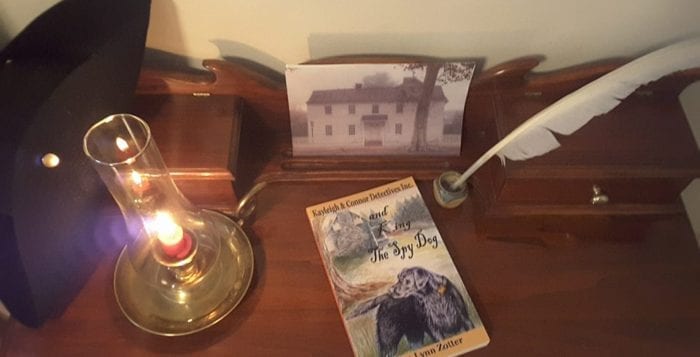Making Memories with Music, a special program for people with dementia and their care partners, returns to the Cinema Arts Centre, 423 Park Ave., Huntington on Aug. 27 at 11 a.m. Facilitated by Marcy Rhodes, the morning will feature a performance by The Jazz Loft Trio — Tom Manuel on cornet and vocals, Steve Salerno on guitar and Keenan Zach on double bass. Admission is $5 per person. Popcorn and beverages will be served. Registration is required by calling 631-423-7610, ext. 0.
Avalon Park & Preserve to host free screening of ‘Sky Quest’
 Avalon Park & Preserve in Stony Brook will present a free screening of the documentary “Sky Quest” at its barn off Shep Jones Lane on Friday, Aug. 24 at 8 p.m. A family favorite, it tells the story of one woman’s quest for astronomy exploration and her childhood dreams of the stars.
Avalon Park & Preserve in Stony Brook will present a free screening of the documentary “Sky Quest” at its barn off Shep Jones Lane on Friday, Aug. 24 at 8 p.m. A family favorite, it tells the story of one woman’s quest for astronomy exploration and her childhood dreams of the stars.
Led by David Cohn and David Barnett, the film will be followed by Sky Lab and Sky Dome viewing of Venus, Jupiter, Saturn, Mars, a waxing gibbous Moon and various deep sky objects around 9 p.m. (weather permitting). Free. For more information or directions, call 631-689-0619 or visit www.avalonparkandpreserve.org.
Photo of the Week
SPARKLING SUNSET
 Pamela Murphy of Stony Brook took this serene sunset picture at West Meadow Beach on Aug. 5 on her iPhone. She writes, “I never tire of gazing and capturing on film the sunsets we are privileged to enjoy at this jewel in our community. The brilliant saturation of colors, in addition to the way the sun was reflecting on the water leading right up to the shoreline, was beautiful to behold.”
Pamela Murphy of Stony Brook took this serene sunset picture at West Meadow Beach on Aug. 5 on her iPhone. She writes, “I never tire of gazing and capturing on film the sunsets we are privileged to enjoy at this jewel in our community. The brilliant saturation of colors, in addition to the way the sun was reflecting on the water leading right up to the shoreline, was beautiful to behold.”
Send your Photo of the Week to [email protected].
Medical Compass: Treating and preventing inflamed hemorrhoids

Most Americans don’t get enough fiber
By David Dunaief, M.D.

Many of us have suffered at one time or another from inflamed hemorrhoids. They affect men and women equally, though women have a higher propensity during pregnancy and child birth. For some reason, there’s a social stigma associated with hemorrhoids, although we all have them. They’re vascular structures that aid in stool control. When they become irritated and inflamed, we have symptoms — and often say we “have hemorrhoids” — when we really mean our hemorrhoids are causing us pain.
When they’re irritated, hemorrhoids may alternate between itchy and painful symptoms, making it hard to concentrate and uncomfortable to sit. This is because the veins in your rectum are swollen. They usually bleed, especially during a bowel movement, which may scare most of us. Fortunately, hemorrhoids are not a harbinger of more serious disease.
Treating external hemorrhoids
Fortunately, external hemorrhoids tend to be mild. Most of the time, they are treated with analgesic creams or suppositories that contain hydrocortisone, such as Preparation H, or with a sitz bath, all of which help relieve the pain. Thus, they can be self-treated and do not require an appointment with a physician. The most effective way to reduce bleeding and pain is to increase fiber through diet and supplementation (1). However, sometimes there is thrombosis (clotting) of external hemorrhoids, in which case they may become more painful, requiring medical treatment.
Treating internal hemorrhoids
Internal hemorrhoids can be a bit more complicated. The primary symptom is bleeding with bowel movement, not pain, since they are usually above the point of sensation in the colon, called the dentate line. If the hemorrhoids prolapse below this, there may be pain and discomfort, as well. Prolapse is when hemorrhoids fall out of place, due to weakening of the muscles and ligaments in the colon.
The first step for treating internal hemorrhoids is to add fiber through diet and supplementation. Study after study shows significant benefit. For instance, in a meta-analysis by the Cochrane Systems Data Review 2005, fiber reduced the occurrence of bleeding by 53 percent (2). In another study, after two weeks of fiber and another two-week follow-up, the daily incidence of bleeding was reduced dramatically (3).
There are several minimally invasive options, including anal banding, sclerotherapy and coagulation. The most effective of these is anal banding, with an approximate 80 percent success rate (4). This is usually an office-based procedure where two rubber bands are place at the neck of each hemorrhoid. To avoid complications from constipation, patients should also take fiber supplementation.
Side effects of the procedure are usually mild, and there is very low risk of infection. However, severe pain may occur if misapplication occurs with the band below the dentate line. If this procedure fails, hemorrhoidectomy (surgery) would be the next option.
How to prevent hemorrhoids
First, sitting on the toilet for long periods of time puts significant pressure on the veins in the rectum, potentially increasing the risk of inflammation. Though you may want private time to read, the bathroom is not the library. As soon as you have finished moving your bowels, it is important to get off the toilet.
Eating more fiber helps to create bulk for your bowel movements, avoiding constipation, diarrhea and undue straining. Thus, you should try to increase the amount of fiber in your diet, before adding supplementation. Fruits, vegetables, whole grains, nuts, beans and legumes have significant amounts of fiber. Grains, beans and nuts have among the highest levels of fiber. For instance, one cup of black beans has 12 g of fiber.
Americans, on average, consume 16 g per day of fiber (5). For the average female or male between ages 31 and 50, the USDA recommends 25 and 30 g per day, respectively (6). I would recommend at least 40 g. My wife and I try to eat only foods that contain a significant amount of fiber, and we get approximately 65 g per day. You may want to raise your fiber level gradually; if you do it too rapidly, be forewarned — side effects are potentially gas and bloating for the first week or two.
Get plenty of fluids. It helps to soften the stool and prevent constipation. Exercise also helps to prevent constipation. It is important not to hold in a bowel movement; go when the urge is there or else the stool can become hard, causing straining, constipation and more time on the toilet.
If you have rectal bleeding and either have a high risk for colorectal cancer or are over the age of 50, you should see your physician to make sure it is not due to a malignancy or other cause, such as inflammatory bowel disease. The message throughout this article is that Americans need to get more fiber, which is beneficial for inflamed hemorrhoid prevention and treatment.
References:
(1) Dis Colon Rectum. Jul-Aug 1982;25(5):454-456. (2) Cochrane.org. (3) Hepatogastroenterology 1996;43(12):1504-1507. (4) Dis Colon Rectum 2004 Aug;47(8):1364-1370. (5) emedicine.com 2010. (6) health.gov.
Dr. Dunaief is a speaker, author and local lifestyle medicine physician focusing on the integration of medicine, nutrition, fitness and stress management. For further information, visit www.medicalcompassmd.com or consult your personal physician.
We invite you to check out our new weekly Medical Compass MD Health Videos on Times Beacon Record News Media’s website, www.tbrnewsmedia.com.
Community Blood Drive heads to Kings Park
 Leg. Rob Trotta will host a blood drive at the Church of St. Joseph, 59 Church St., Kings Park on Thursday, Aug. 23 from 1:30 to 7:30 p.m. Your donation can help to save up to three lives. Please share this lifesaving gift. All donors will receive a voucher for a free pair of Mets tickets. For more information or to schedule an appointment, call Susan at 631-854-3900.
Leg. Rob Trotta will host a blood drive at the Church of St. Joseph, 59 Church St., Kings Park on Thursday, Aug. 23 from 1:30 to 7:30 p.m. Your donation can help to save up to three lives. Please share this lifesaving gift. All donors will receive a voucher for a free pair of Mets tickets. For more information or to schedule an appointment, call Susan at 631-854-3900.
Port Jefferson Greek Festival celebrates 57 years of tradition

By Sabrina Petroski
Souvlaki, gyros, baklava, oh my! Is your mouth watering yet? Try all of these dishes and more as the Greek Orthodox Church of the Assumption in Port Jefferson celebrates its 57th annual Port Jefferson Greek Festival from Aug 23 through 26. This year’s event will feature carnival rides, traditional dance performances, live music, games and culinary delights.

Authentic Greek dishes such as gyros, moussaka, tiropita, souvlaki and spanakopita will be served up, along with sweet desserts such as melomakarona, galaktoboureko, kourabiedes, koulourakia, baklava and loukoumades, a fried dough pastry favorite.
According to Marisa Raptis, the president of the Parish Council, members of the church will be making the food on sight and fresh to order. Popcorn, cotton candy and pretzels will also be available.
Guided tours of the church will be available throughout the day, and over 30 vendors will be scattered around the church grounds selling jewelry, home goods, clothes, beauty products, candles and other handmade items.
One of the main attractions at the festival is the over-the-top sweepstakes that the church holds. This year 315 prizes will be awarded including cars — a 2018 Mercedes Benz GLC 300 4Matic is first prize — an Alexa Smart Device, a Bose Home Theater, an iPod Touch, a Nespresso Mini, cash prizes and much more. Tickets for the sweepstakes are $100 each, limited to 4,999 tickets — meaning that one out of 16 will win a prize. The drawing will be held on Aug. 26 at 7 p.m.

In addition, there will also be live performances throughout the weekend for guests to enjoy. The Hellenic Dance Troupe will be performing on Saturday as well as the church’s Youth Dance Troupe, showing off the traditional Greek style of dance. A five-piece band will take the stage Friday through Sunday with tunes that will make you want to get up out of your seat, and a DJed fireworks show will turn heads on Friday and Saturday night, weather permitting.
“People should come because we are one of the largest Greek festivals on Long Island,” said Raptis in a recent email. “Where else can you go on a Friday night and eat dinner under the stars while listening to live music and watching fireworks?,” adding, “I am most excited about being with my Greek community for four days as we show our love for our culture to everyone with music, food and dancing!”
The festival will take place, rain or shine, from 5 to 10 p.m. on Aug. 23, 5 to 11 p.m. on Aug. 24, 1 to 11 p.m. on Aug. 25 and 1 to 10 p.m. on Aug. 26. Tickets are $2 per person, and children under 12 can attend for free. A shuttle service will be available from Ward Melville High School to the church. Raffle tickets may be purchased online at www.portjeffgreekfest.com.
The Greek Orthodox Church of the Assumption is located at 430 Sheep Pasture Road, Port Jefferson. For more information, call the church office at 631-473-0894.
Book Review: ‘Kayleigh & Connor Detectives Inc. and King The Spy Dog’
By Beverly C. Tyler
Telling stories about the men and women of the Culper Spy Ring and portraying Setauket spy leader Abraham Woodhull has been one way for me to bring local history to life for both residents and visitors to this area. Reading about the Culper spies is also important, so I have written a number of articles and recommended books that tell the story. I have recently read and enthusiastically recommend “Kayleigh & Conner Detectives Inc. and King The Spy Dog” for children of all ages.

Written and illustrated by Dana Lynn Zotter, this 174-page soft-cover book tells the story of two children, Kayleigh and Connor, who spend their last week of summer vacation visiting their great-grandparents in Stony Brook who live in a historic house that holds all kinds of secrets.
When the children find a gravestone with the name KING engraved on it in the roots of an old tree, their great-grandfather tells them that there was once a legendary spy dog named King in the area who has appeared as a ghost. The siblings meet a local boy and, as detailed on the back cover, “Three children search for the truth about ghosts, legends, and Long Island’s Culper Spies.”
Zotter has woven a delightful tale of a family and their experiences in the Long Island communities of Stony Brook, Setauket and Port Jefferson together with an accurate portrayal of the men and women involved in the Revolutionary War Culper Spy Ring. This well-crafted story vividly transports the reader to the historic hamlet of Stony Brook where the children explore their great-grandparents’ Colonial-era home and the shoreline of this picturesque community.
As Kayleigh and Connor explore, they discover mysteries connected with the house and the community, including an appearing and disappearing black dog named King. Agreeing to become detectives and follow the clues, the children discover how the Culper spies operated and how King the spy dog became an important member of the Culper Spy Ring.
Their travels take them along West Meadow Creek and as far as the Village of Port Jefferson where they meet General Lafayette on a recreated 18th-century French warship, which actually visited Greenport in 2015. At one point the children are mysteriously transported back to the Revolutionary War and join the Culper spies and King the spy dog on a brief spy adventure.

“Kayleigh & Conner Detectives Inc. and King The Spy Dog” features 22 illustrations, including a recipe for invisible ink and a spy code, along with a list of historic places to visit. The drawings, including one of the Setauket Presbyterian Church and cemetery, help bring the story to life without taking away from the writing, allowing readers full use of their imaginations. I enjoyed the story and easily identified with the characters.
Dana Lynn Zotter, who describes herself as a gardener, poet, artist and finder of four-leaf clovers, has crafted a wonderful story that will delight children and make historians smile.
“Kayleigh & Conner Detectives Inc. and King The Spy Dog” is available at the Three Village Historical Society’s gift shop, 93 North Country Road, Setauket. Hours of operation are Monday through Friday, 10 a.m. to 3 p.m. and Sundays from 1 to 4 p.m. For more information, call 631-751-3730 or visit www.tvhs.org.
Author Beverly C. Tyler is the Three Village Historical Society historian and pens a biweekly column in the Village Times Herald titled History Close at Hand.
Life Lines: How did you get your face?
By Elof Axel Carlson

In 1974 I was a Hill Foundation visiting professor at the University of Minnesota, invited by the History of Science Department to interact with its faculty and students. One faculty member who showed up to my seminar class was Robert Desnick who was interested in medical genetics and he had completed both an M.D. and Ph.D.
Four years later I arranged with Desnick, who was on the faculty of the medical school, to go on rounds with his pediatric fellows so I could learn what human genetics disorders were like (30 percent of the pediatric patients had some medical genetic condition). I also used my time there to study the genetics of retinoblastoma, a cancer of the eye in children that can affect one or both eyes, and I published two papers with Desnick on that study. I also met Robert Gorlin who had a dental degree and became a world expert on syndromes of the head and neck and whose book on those conditions was a classic (now in its fifth edition).
I thought about those experiences recently as I read articles in the Public Library of Science (PLoS) on the web about the genetics of the face. All vertebrates have heads with eyes, nose, mouth and ears. I knew from my embryology class as a graduate student that the vertebrate embryo forms a neural tube and one end balloons into a brain. A group of cells along the seamline of the tube migrates and portions of it form the face as do slabs of embryonic tissue that come together to form the skull or cranium. Genes controlling these movements and managing the tissues involved were known from a variety of genetic disorders that Gorlin and Desnick had been following.
In reading the PLoS articles I felt like Rip van Winkle becoming acquainted with a new world that I had slept through. There are now almost a thousand syndromes of human disorders of the head, neck and face. Hundreds of genes involved have been isolated and sequenced. A smaller portion have had their functions worked out. There is one major gene for cleft lip and palate and dozens of other genes that can modify its severity. Some are tied to a vitamin (folic acid) deficiency and may also lead to spina bifida.
 The story unfolding at a molecular level is still in its infancy but enough is known to make some reasonable predictions. In a few decades it may be possible to examine the DNA of persons (even mummies or the bones of ancient humans) and reconstruct on a computer screen the portraits of their faces as adults. I toyed with this possibility in 1968 in a public lecture I gave at UCLA (50 years go by like a flash when you turn 87). Back then it was all based on speculation.
The story unfolding at a molecular level is still in its infancy but enough is known to make some reasonable predictions. In a few decades it may be possible to examine the DNA of persons (even mummies or the bones of ancient humans) and reconstruct on a computer screen the portraits of their faces as adults. I toyed with this possibility in 1968 in a public lecture I gave at UCLA (50 years go by like a flash when you turn 87). Back then it was all based on speculation.
In 50 years, as the PLoS articles demonstrate, the changes in knowledge are accelerating thanks to the zebrafish (Danio rerio) as a model organism for vertebrate embryology. The zebrafish embryo has transparent cells, so one can look at embryos forming and identify each of the cells involved.
Biologists have known since Darwin’s writing in the 1860s that facial expressions exist among animals, but humans are remarkable in the nuances facial expressions convey — a Mona Lisa smile, a raised eyebrow of skepticism, a pout, a crying child and the contracted muscles of a bigot shouting slurs are only a few of the many ways we read other people’s faces. At present we can only guess how many genes are involved in these facial gestures. A genetic component is involved because identical twins raised apart for many years show remarkable similarity in their facial expressions and mannerisms.
Elof Axel Carlson is a distinguished teaching professor emeritus in the Department of Biochemistry and Cell Biology at Stony Brook University.
Long Island Museum receives loan of historic portraits

On Aug. 7, Town of Brookhaven Supervisor Ed Romaine (R) and town historian Barbara Russell visited the Longwood Estate (circa 1790) in Ridge where they presented two historic paintings to Joshua Ruff, director of collections and interpretation at The Long Island Museum in Stony Brook, to be added to the museum’s collection as a long-term loan.
The portraits, painted by Shepard Alonzo Mount, were gifted to the town by Eleanor Smith of California. The subjects are William Sidney Smith (1796–1879) and his wife, Eleanor Jones Smith (1805–1884). A year after their marriage in 1823, the couple came to Longwood Estate and raised 10 children. William Smith served as Brookhaven Supervisor from 1829 to 1834.
“These pieces were donated to the Town of Brookhaven, they still belong to the Town of Brookhaven, but they are coming to the museum and will be stored in our collections to be used occasionally for exhibition purposes,” said Ruff in a recent phone interview. “We agreed in taking them as a long-term loan because we believe they really add to our holdings on Shepard Alonzo Mount.”
Painted in the early 1830s, the two portraits were displayed in the house on the property until the last Smith family owner, Eleanor Northrup Smith, sold the estate and moved to California in the late 1960s. The paintings have been stored in a warehouse since that time.
Albeit a loan, Ruff is thrilled to be able to add them to the museum’s current collection, which includes more than 25 of Shepard Alonzo Mount’s paintings and several hundred of his drawings and sketches, not to mention the enormous collection of paintings and drawings by his more famous younger brother, William Sidney Mount.
According to Ruff, these particular portraits are unique in that they precede the portrait paintings the museum has, which are from the later 1830s and 1840s. “They were done just when [Shepard] was starting to launch his career as a portrait artist. This was a phase of his career that we hadn’t really documented before. They are valuable in that sense to us,” he said. “They show him beginning to mature as an artist and improve in his skills.”
Making Democracy Work: How a grand idea became reality
By Nancy Marr
In 1978 Suffolk County Planner Lee Koppelman suggested a trail along Long Island’s North Shore for hikers and bikers. Forty years later, as a result of the efforts of elected officials, community groups and individual citizens, funding for a trail from Mount Sinai to Wading River was approved by the Suffolk County Legislature, with plans to start construction in 2019. How do such ideas become reality in our communities?
By the time the Setauket to Port Jefferson Greenway Trail (on 3½ miles of New York state land) was completed in 2014, its supporters had been trained in advocacy. With the Three Village Community Trust as overseer, local residents and organizations supported the trail, raised funds to supplement the state and federal grants and contributed labor to complete the trail. As the trail was being built, the civic associations, the Long Island Mountain Bicyclists and other nonprofits played a role. When they needed Department of Environmental Conservation approval to pass through the Lawrence Aviation property, they pushed to get it.
 Thus when the new Rails to Trails group needed “persons of interest” to attend official government meetings, or informed residents to speak at community meetings, skilled home-grown activists were well-established and ready to work together on this ambitious goal. But advocates also knew that they needed an engaged local elected official who could help navigate the system and secure government support. When Sarah Anker (D-Mount Sinai) became a Suffolk County legislator in 2011, this trail became a legislative goal.
Thus when the new Rails to Trails group needed “persons of interest” to attend official government meetings, or informed residents to speak at community meetings, skilled home-grown activists were well-established and ready to work together on this ambitious goal. But advocates also knew that they needed an engaged local elected official who could help navigate the system and secure government support. When Sarah Anker (D-Mount Sinai) became a Suffolk County legislator in 2011, this trail became a legislative goal.
Anker got past her first roadblock when County Executive Steve Bellone (D) enthusiastically endorsed the idea of creating the trail along Route 25A. The second roadblock, property owner LIPA’s concern about liability, was removed when the county executive worked out an agreement to lease and maintain the property, creating a “linear park” that would be cared for by the Parks Department and the county police. Community opposition, however, mounted at the idea of losing privacy with strangers passing near homes along the trail. With the experienced help of Friends of the Greenway Chair Charles McAteer, county legislators organized public meetings to discuss residents’ concerns.
When the Legislature voted on the request to bond the federal money (that will be paid back in grants) on July 17, so many supporters spoke positively that it passed with only one abstention. The federal funding that had been obtained in prior years by congressmen Felix Grucci and Tim Bishop was delayed until 2016 when Congressman Lee Zeldin (R-Shirley) secured final approval of almost $10 million.
The groundswell of support from the community and Anker’s continuing commitment will make the trail’s future secure. Working together, the legislator and the community overcame many obstacles to the establishment and funding of the trail in the past 7 years. This project serves as a strong case study for Suffolk County citizens in advocating, building community support for a grand idea, finding a legislative champion and working together to make it a reality.
Nancy Marr is first vice president of the League of Women Voters of Suffolk County, a nonprofit, nonpartisan organization that encourages the informed and active participation of citizens in government and influences public policy through education and advocacy. For more information, visit www.lwv-suffolkcounty.org, email [email protected] or call 631-862-6860.











